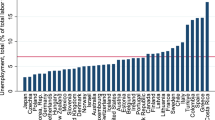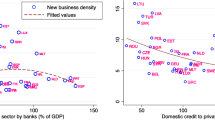Abstract
This paper investigates the relationship between financial development and labor-market volatility in 15 OECD countries from 1974 to 2007. I argue that financial development should affect corporate governance and then how firms will determine wages and the number of hours worked, especially for low-skilled workers. First, my results indicate that financial development is associated with higher employment and wage volatility, but with no significant differences across skill levels. Second, using a threshold regression model, I show that the increasing effect of higher financial development on labor-market volatility is larger in countries with more labor-market regulation.
Similar content being viewed by others
Notes
For instance, the traditional compromise between blockholders, managers and trade unions in Germany was undermined when large German banks (such as Deutsche Bank, Dresdner Bank) in the mid-1980s ceased to play their traditional role of ‘patient capital’ providers to benefit from the internationalization of the Anglo-Saxon banks. Gradually, banks sold the shares they held in firms, withdrew from their management and supervisory boards and became investment banks. Obviously these evolutions directly affected the behavior of large German firms, becoming more sensitive from the pressures to generate ‘shareholder value’.
Automatic stabilizers are specific features of government spending to dampen the fluctuations in real GDP. Fatas and Mihov (2001) show that government expenditure through automatic stabilizers has a reducing effect on output volatility.
Rodrik (1997) finds no empirical evidence of this argument when country-specific characteristics are controlled for fixed-effects.
Labor compensation converted into constant US dollar is obtained by using the exchange rate series from the Penn World Tables and by deflating by the US output price index.
I use in robustness checks the share of domestic credit to private sector by banks in the GDP as another common measure of financial sector depth.
Other common measures of labor market regulation, such as the strictness of employment protection legislation and the degree of coordination in wage bargaining, have been used in the analysis. But, the threshold regression method used in the empirical analysis in the section ‘Estimation results’ indicates that these two different variables cannot be used to sample-split. I fail to reject the null hypothesis of no threshold H0:β1=β2.
Unemployment and sickness generosity indexes are calculated on replacement rate, qualification period, duration, waiting days and coverage. Pension generosity index is calculated on replacement rate, expected pension duration years, pension qualification years and employee pension funding ratio.
F-tests have been run to test the presence of year fixed-effects. The null hypothesis assumes that all year coefficients are equal to zero. If I fail to reject the null, no time fixed-effects are needed only when considering employment volatility as dependent variable.
I find very similar and robust results when calculating my measures of labor market volatility with different values of λ (such as λ=100). Using alternative filters such as the Baxter–King filter, gives substantially similar results.
Results of this test are not here reported.
Using more bootstrap replications gives very similar results.
Models (7) and (8) indicae that higher stock market development is associated with a reduction (and not an increase as expected) in labor-market volatility for higher values of welfare generosity. Some recent contributions have shown that labor market institutions have a reducing effect on the volatility of real wage growth (Macit, 2010; Buch and Schlotter, 2011). Strong labor market regulation allows to maintain workers’ wages and lead to smoother responses in real wages. Accordingly, the increasing effect of financial development on wage volatility is undermined by the reducing effect of welfare state and labor market variables, including for high-skilled workers.
References
Beck, T, Asli Demirgüç-Kunt, A and Levine, R . 2010: A new database on financial development and structure. World Bank, http://econ.worldbank.org/WBSITE/EXTERNAL/EXTDEC/EXTRESEARCH/0,,contentMDK:20696167~pagePK:64214825~piPK:64214943~theSitePK:469382,00.html, accessed 25 January 2016.
Bertola, G and Lo Prete, A . 2015: Labor market reforms, finance, and the current account. Review of International Economics 23 (3): 469–488.
Broto, C, Diaz-Cassou, J and Erce, A . 2011: Measuring and explaining the volatility of capital flows to emerging countries. Journal of Banking and Finance 35 (8): 1941–1953.
Buch, CM and Schlotter, M . 2011: Regional origins of employment volatility: Evidence from German states. Empirica 40 (1): 1–19.
Buch, CM and Pierdzioch, C . 2014: Labor market volatility, skills, and financial globalization. Macroeconomic Dynamics 18 (5): 1018–1047.
Cairo, I and Cajner, T . 2014: Human Capital and Unemployment Dynamics: Why More Educated Workers Enjoy Greater Employment Stability, Finance and Economics Discussion Series, Federal Reserve Board, 2014–09.
Chatelain, JB and Ralf, K . 2014: Spurious regressions and near-multicollinearity, with an application to aid, policies and growth. Journal of Macroeconomics 39 (A): 85–96.
Checchi, D and Garcia-Penalosa, C . 2008: Labour market institutions and income inequality. Economic Policy 23 (56): 600–651.
Darcillon, T . 2015: Corporate governance reforms and political partisanship: An Empirical Analysis in 16 OECD Countries. Business and Politics 17 (4): 661–676.
Erauskin, I . 2011: Financial openness, volatility, and the size of productive government. SERIEs 2 (2): 233–253.
Fatas, A and Mihov, I . 2001: Government size and automatic stabilizers: International and intranational evidence. Journal of International Economics 55 (1): 3–28.
Gourevitch, PA and Shinn, J . 2005: Political power and corporate control: The new global politics of corporate governance. Princeton University Press: Princeton.
Greenwood, J and Jovanovic, B . 1990: Financial development, growth, and the distribution of income. Journal of Political Economy 98 (5): 1076–1107.
Hansen, B . 1999: Threshold effects in non-dynamic panels: Estimation, testing, and inference. Journal of Econometrics 93 (2): 345–368.
Jacoby, SM . 2008: Finance and labor: Perspectives on risk, inequality, and democracy. Comparative Labor Law & Policy Journal 30 (1): 17–65.
Jetter, M, Nikolsko-Rzhevskyy, A and Smith, WT . 2013: The effects of wage volatility on growth. Journal of Macroeconomics 37 (1): 93–109.
Macit, F . 2010: The role of labor market institutions on wage and inflation dynamics: Empirical evidence from OECD economies. Economic Analysis & Policy 40 (1): 49–62.
OECD. 2007: OECD workers in the global economy: Increasingly vulnerable? OECD employment outlook 2007. OECD Publishing: Paris.
OECD. 2011: Earnings volatility: Causes and consequences. OECD employment outlook 2011. OECD Publishing: Paris.
Pagano, M and Pica, G . 2012: Finance and employment. Economic Policy 27 (69): 5–55.
Pagano, M and Volpin, P . 2005: The political economy of corporate governance. American Economic Review 95 (4): 1005–1030.
Ravn, MO and Uhlig, H . 2002: On adjusting the Hodrick-Prescott filter for the frequency of observations. The Review of Economics and Statistics 84 (2): 371–380.
Rodrik, D . 1997: Has globalisation gone too far? Institute for International Economics: Washington DC.
Rodrik, D . 1998: Why do more open economies have bigger governments? Journal of Political Economy 106 (5): 997–1032.
Roe, MJ . 2003: Political determinants of corporate governance. Political context, corporate impact. Oxford University Press: Oxford.
Sala, H, Silva, JI and Toledo, M . 2012: Flexibility at the margin and labor market volatility in OECD countries. Scandinavian Journal of Economics 114 (3): 991–1017.
Scheve, K and Slaughter, MJ . 2004: Economic insecurity and the globalization of production. American Journal of Political Science 48 (4): 662–674.
Scruggs, L, Detlef, J and Kati, K . 2014: Comparative welfare entitlements dataset 2. Version 2014–03. University of Connecticut & University of Greifswald, http://cwed2.org/, accessed 25 January 2016.
Sjöberg, O . 2009: Corporate governance and earnings inequality in the OECD countries 1979–2000. European Sociological Review 25 (5): 519–533.
Solt, F . 2009: Standardizing the world income inequality database. Social Science Quarterly 90 (2): 231–242.
Stiglitz, JE . 2000: Capital market liberalization, economic growth, and instability. World Development 28 (6): 1075–1086.
Thesmar, D and Thoenig, M . 2004: Financial market developments and the rise in firm level uncertainty. Centre for Economic Policy Research: London, http://www.cepr.org/active/publications/discussion_papers/dp.php?dpno=4761, accessed 25 January 2016.
Wasmer, E . 2006: Interpreting Europe-US labour market differences: The specificity of human capital investments. American Economic Review 96 (3): 811–831.
Acknowledgements
The author wants to thank Bruno Amable, Karim Azizi, Christophe Rault, Antoine Rebérioux, all participants of the 25th Annual Conference of the Society for the Advancement of Socio-Economics (SASE) at the University of Milan, 27–29 June 2013, two anonymous referees and the Editor for valuable comments on a previous version.
Author information
Authors and Affiliations
Appendix
Rights and permissions
About this article
Cite this article
Darcillon, T. Labor-Market Volatility and Financial Development in the Advanced OECD Countries: Does Labor-Market Regulation Matter?. Comp Econ Stud 58, 254–278 (2016). https://doi.org/10.1057/ces.2016.2
Published:
Issue Date:
DOI: https://doi.org/10.1057/ces.2016.2
Keywords
- financial development
- labor-market volatility
- labor-market regulation
- social and welfare policies
- threshold regression model




